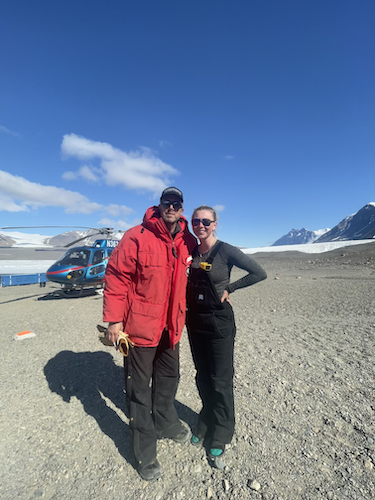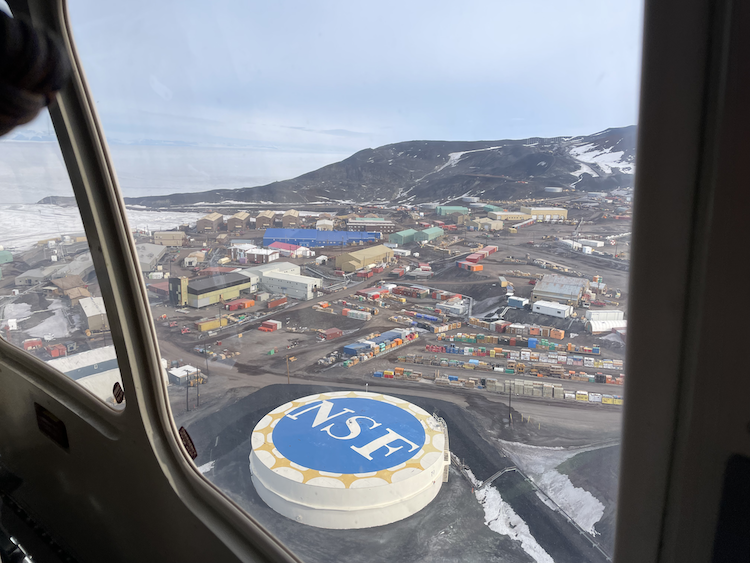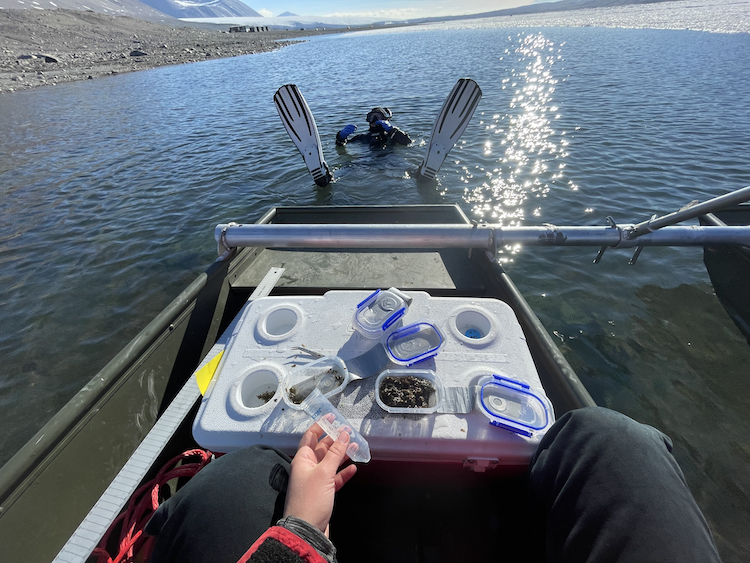Leora Wilson Shares Her Research Experience in Antarctica

Leora Wilson, a senior geophysics major at LSU, and Dr. Peter Doran.Photo Credit: Leora Wilson
Students in the LSU College of Science have the opportunity to take part in hands-on
research opportunities all over the world. The College of Science sends students far
and wide every semester, across the United States, and to every continent.
LSU Geology and Geophysics’ focus on Polar Studies is led by Peter Doran, Sophie Warny and Phil Bart. The three study the changing ecosystems of Antarctica, such as the retreat of the
West Antarctic Ice Sheet and biological activity in ice-covered lakes.
For two and a half months Leora Wilson, a senior in the LSU Geology and Geophysics
department and a College of Science Ambassador, participated in research at the McMurdo
Dry Valleys Long Term Ecological Research (LTER) Project in Antarctica with Dr. Peter
Doran.
Wilson left on Nov. 23rd, 2022, on a 17-hour flight from Houston to Sydney. Wilson
said she spent her 11-hour layover in Sydney eating as many fresh fruits and vegetables,
and visiting as many greenhouses and botanicals as she could, as it would be the last
time for almost three months she would see vegetation.
She then flew from Syndey to Christchurch, New Zealand, and finally a 7-hour-flight
from Christchurch to Antarctica. After arriving on November 26, Wilson spent a few
days acclimating to the arctic continent at McMurdo Station, the largest station on
Antarctica.
“I really enjoyed meeting all the interesting people that work and live down there
for extended periods of time. It’s nice to think of McMurdo as a small town,” Wilson
said of the station built on volcanic rock and located on the southern tip of Ross
Island.
The station’s population fluctuates up to 1,000 people during the summer and down
to 250 people in the winter. The station has more than 80 buildings, including dorms,
a 24/7 cafeteria, a free coffee shop, bars, a gym and other amenities.
While at McMurdo, Wilson helped in the Crary Lab where LTER researchers process soil,
water, ice and a range of other samples. Within most samples in the lab, scientists
look for nitrogen, sulfides, sulfates, phosphorus, carbon and oxygen to analyze the
area’s biological productivity. The surrounding ice melt nutrient flows, and minerals
from various rock formations, are able to support microscopic life, such as nematodes
and archaea. However, research is still being conducted in these extreme environments
and the ecological dynamics are still yet to be fully understood.

McMurdo Station, as pictured by Leora Wilson from a helicopter, is the largest settlement on Antarctica, home to as many as 1,000 people during summers.Photo Credit: Leora Wilson
After a few days at McMurdo Station, Wilson spent the next two months at Lake Fryxell
in the McMurdo Dry Valleys of East Antarctica, a 45-minute helicopter ride from the
station, where she met up with the researcher she was assisting, Dr. Peter Doran.
“We just kind of did our own thing when we were not on the ice,” Wilson said. Other
researchers came and went, however. Wilson said the number of people at the Lake Fryxell
camp fluctuated between two and nine.
At Lake Fryxell, Wilson helped drill and melt dive holes for the LTER teams, including
the limnology team and Soil-Lake Inundation Moat Experiment (SLIME) project.
The SLIME team regularly drills holes in the ice to track the thickness of the moat
ice throughout the year in different regions of the lake. The moat between the land
and ice sheet on the lake melts each year, spanning 5 to 10 feet on average. This
exposes the microbial mats in open water, which they took samples of to analyze for
variations in laminae, or thin layers of the mat.
Microbial mats are large blankets of organisms that span shallow regions of the lake
that get adequate light to support these photosynthesizing microbes. At a certain
depth, sections of the mat can break off and rise to the surface due to an increased
amount of gases trapped within their “webs.”
“The float mat samples were the most interesting to collect,” said Wilson. “You would
just hear the divers struggling to collect these samples because as they get closer
to the floating samples, they drift away due to the bubbles from the regulator.”
The SLIME project studies the microbial mats and cyanobacteria in these isolated glacial
lakes as an example of evolution of early life. Understanding the physiochemical characteristics
in these environments helps the researchers understand how modern organisms developed
the ability to photosynthesize and respire, Wilson said.
At the dive holes, Wilson was responsible for upholding vital safety procedures, such
as maintaining the air surface supply and readying an emergency scuba set. Every morning,
she established communications with McMurdo Station in case an emergency occurred
during a dive. She also set up the air supply control panels, and kept track of dive
data, such as the duration of the dive, the maximum depth, and total pounds-per-square-inch
of air used.

Abbey Dias (in water) gives Leora Wilson samples to organize before being sent to McMurdo Station for analysis.Photo Credit: Leora Wilson
During her two months at Lake Fryxell, Wilson also collected freshwater samples for
the limnology team at McMurdo to test for an abundance of various minerals. She also
collected soil samples for researches at McMurdo to search for nematodes, water bears,
and other bacteria and microbes with the soils team.
While at the camp at Lake Fryxell, Wilson got to experience the life of a field researcher.
She slept in a one-person tent. They had a small permanent hut where there was a kitchen
with a stove, microwave and a dining table. Wilson said the food she ate while at
the camp was surprisingly good. She was able to request her own food and cook anything
she wanted. The stove allowed the researchers to get more sophisticated with their
frozen and canned foods than one might expect possible in such conditions, she said.
However, the camp did not have running water. Instead, they pumped water from the
moat around Lake Fryxell, and collected small chunks of ice (nicknamed “glacier berries”),
to boil. After they boiled the water for safety, they stored it in a Gatorade jug
and washed their hands under its spout.
Every morning, Wilson woke up at 7, ate breakfast and called into McMurdo Station
for a daily check in before heading to the dive holes around 9 a.m.
“I became the camp coordinator in a way. I kept up with the daily helicopter schedule,
kept track of waste drum volume, poop buckets, propane, and inventory for the various
project groups. I also did the morning check in with McMurdo where I asked for the
daily weather and the joke of the day,” Wilson said.
Wilson visited other camps, too. She helped replace data logs and fix equipment at
four other meteorological stations: Lake Brownworth, Lake Vanda, Lake Vida, Commonwealth
Glacier and Canada Glacier. Each meteorological station has a range of sensors and
instruments that collect solar radiation, wind speed and direction, soil temperature,
air temperature, relative humidity, shortwave and long wave radiation in and out of
the soil or ice, and various others depending on the location of the station.
“Lake Vanda was the most noteworthy MET station I visited, as it is the station that
collected the lowest recorded temperature in Antarctica: minus 69 degrees Celsius,”
Wilson said.
On Jan. 17, 2023, Wilson flew from Antarctica to Christchurch, New Zealand. Next,
she took a quick flight from Christchurch to Auckland, New Zealand, then a 13-hour
flight from Auckland to Los Angeles. Then a flight from Los Angeles to Houston, and
a final flight from Houston to Baton Rouge. In total, it was two full days of travel
return home on the night before the start of the Spring 2023 semester.
Learn more about Leora and the McMurdo Dry Valleys Long Term Ecological Research (LTER) Project on our blog!
###
Feature by Joseph T. Bullard, LSU Manship School of Mass Communication and Leora Wilson, LSU Department of Geology and Geophysics